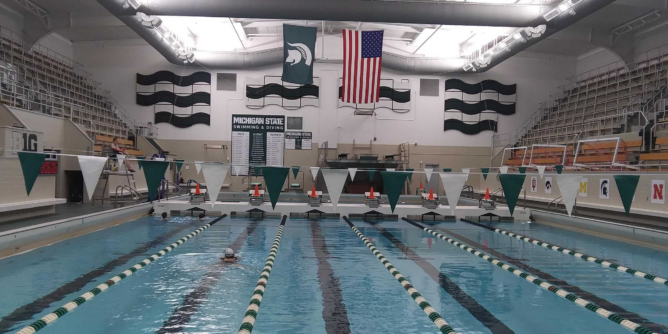
Bill Beekman issued a unilateral directive to axe Swimming and Diving, yet it’s hard to contemplate his financial rationale, after all, cutting Swimming & Diving is tantamount to cancelling the weekly newspaper to balance the family’s household budget.
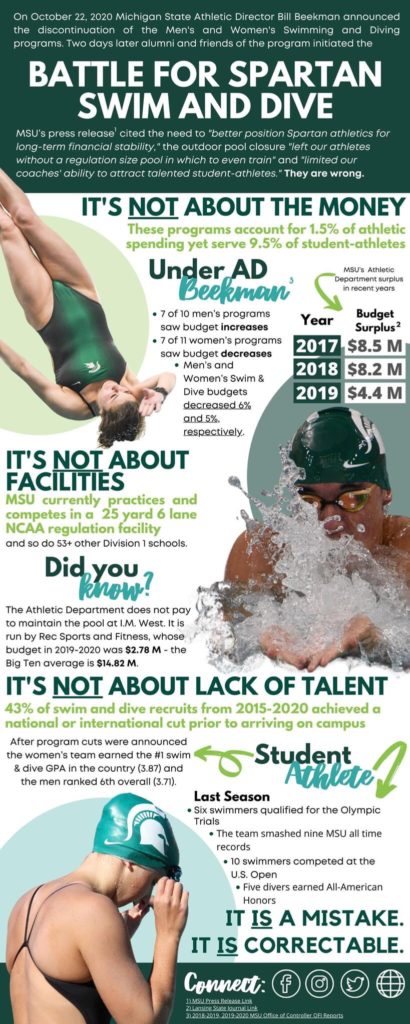 In everyday vernacular, the AD’s decision epitomizes the axiom: Penny wise & pound foolish, because Swimming and Diving is amongst the least expensive and most affordable of all college sports.
In everyday vernacular, the AD’s decision epitomizes the axiom: Penny wise & pound foolish, because Swimming and Diving is amongst the least expensive and most affordable of all college sports.
It goes without saying, the AD can’t make the case that Swimming and Diving is losing money, because Swimming and Diving is by definition a non-revenue sport and therefore doesn’t produce revenue.
So, it seems apparent that axing Swimming & Diving is a deflection of a deeper problem.
An unspoken message that revenue sports, primarily football, the largest generator of athletic revenue, is not producing enough revenue to adequately support the modest expenses of non-revenue sports, including Swimming & Diving…and that’s a problem!
And that’s the other side of this missive which we will look at below.
Non-revenue sports were the pride of John Hannah
Non-revenue sports were the pride of former President John Hannah.
They played a major role in Hannah’s plan to transform Michigan State College into one of the largest research universities in the world.
Non-revenue sports were also Hannah’s ticket for admission into the Big Ten because non-revenue sports identified Michigan State as a well-rounded public university.
While, revenue sports such as Football, Basketball and Hockey bring thousands of fans and media onto campus to enjoy the pageantry of bigtime athletics, on the other hand, nonrevenue sports play another role: they are emblematic of the wider and broader college experience. A human experience, a sense of culture and humanity if you will.
After promoting Biggie Munn to AD in 1954, Hannah gave Munn a mission to elevate non-revenue sports onto the national stage, and Munn did just that.
By the 1960’s, non-revenue sports such as Gymnastics, Swimming & Diving, Track & Field, Wrestling and more, were amongst the best in the Big Ten, going toe to toe with the best in the nation,
Yet, after President Hannah stepped down in 1969, and Biggie Munn stepped down as AD in 1971, non-revenue sports were de-emphasized: Men’s Gymnastics was axed, Men’s Track & Field is a shell of its former glory, and Wrestling has fallen to the bottom of the Big Ten.
And now, Bill Beekman has decided to axe Swimming & Diving? What’s his rationale?
What does Bill Beekman achieve by axing Swimming & Diving one of the least expensive and most affordable of all athletic programs?
Let’s look at athletic revenue from 35,000 feet:
Based upon 2019 data collected from 227 public universities (2020 data is unavailable), Michigan State ranks #6 in athletic revenue* when measured amongst Big Ten schools, and #18 when ranked against 227 public universities across the land.
(*Note: athletic revenue includes Ticket Sales, Contributions, TV& Radio, e-commerce, sponsorships, licensing, advertising, trademarks & royalties, apparel, food, concessions, parking, and more)
In that context, Michigan State posted athletic revenue of $140 Million (rounded), and amongst Big Ten schools, Ohio State, Michigan, Penn State, Wisconsin and Iowa generate more revenue and rank higher.
On the other hand, Michigan State ranks ahead of other Big Ten universities such as Nebraska, Minnesota, Indiana, Illinois, Purdue, Maryland and Rutgers (while data from Northwestern as a private institution, is unavailable).
Michigan State also ranks ahead of nationally recognizable universities such as Clemson, University of Washington, Oregon, University of Virginia and UCLA.
Yet, athletic revenue is meaningless unless there is a surplus, and we can report Michigan State posted a $4Milion surplus after all expenses were paid, including expenses for Swimming & Diving.
In terms of surplus, Michigan State also ranks #6 amongst Big Ten schools.
Of course, I would be remiss if I didn’t mention the financial impact of the virus. The financial impact was felt by every school in the country in 2020, yet it’s a fair assumption that Michigan State was not impacted any more, or any less.
And while Michigan State ranks a respectable #6 when measured in the Big Ten in terms of both Revenue and Expenditures, yet it is falling short of optimizing revenue potential from each of the categories cited above.
Athletic and Academic ambassadors:
Swimming and Diving is low maintenance.
While football programs across the land are comprised of rosters that normally exceed 100 players (including 85 “full” scholarship players) it means expenses for football are enormous when we consider: room, board, tuition, books, tutors and meals.
And when we add in the cost of “away games”, there is the cost of chartered aircraft, filled to capacity with players, coaches, staff and supporters, plus surface travel and hotel accommodations (of course, no one begrudges these expenses because it’s simply the cost of doing business, nevertheless the costs are considerable).
Yet on the other hand, Swimming & Diving operate on a tiny budget of 1.5% of total revenue or a tick above $2Million deducted from $140Million in revenue.
What seems to be forgotten in the AD’s decision to axe Swimming and Diving is the fact Swimming & Diving athletes are athletic ambassadors that give more than they get.
Swim & Dive athletes are amongst the best in terms of GPA, yet most are on partial scholarships and legal infractions are essentially nonexistent.
So what does Michigan State gain by cutting Swimming & Diving, and what did Bill Beekman achieve?
At the bottom line:
The implications of cutting Swimming & Diving are huge.
What’s next? Track & Field, Golf, Soccer, Wrestling? All of the above and more?
The role of the AD should be to optimize the athletic experience while increasing revenue and thereby ensuring nonrevenue sports have an opportunity to excel.
While justifying his decision to axe Swim & Dive, the AD declared that Swimming and Diving facilities were inadequate, yet in business, if capital improvements are needed, managers and executives are expected to increase revenue.
University of Texas is a prime example.
UT ranks #1 in athletic revenue at an astounding $224Million offset by expenses of $204Million, and that translates to a surplus of $20 Million per year. That’s extraordinary.
The gameday experience at UT is extraordinary as well: the stadium is filled to capacity of 100,000 each game day and that means revenues are robust, and that enables UT athletic department to grow without splitting hairs. But UT also optimizes every single revenue source notably gameday concessions and licensed apparel.
Of course, UT Football takes care of its business by winning 76% of home games and that optimizes donations and contributions.
So, if a new pool was needed at UT, they have the surplus to build a new pool, or new soccer field, or whatever.
Back in the day, from 1948 to 1965, John Hannah along with Biggie Munn subscribed to a massive capital improvement strategy thereby improving facilities for all sports across the landscape. As it relates to football, Spartan Stadium expanded in 3 different stages by more than 50,000 seats, from 26,000 to 76,000 thereby increasing attendance, and subsequently increasing athletic revenue that ensured the viability of nonrevenue sports.
Hannah and Munn also improved Jennison and constructed the IM Building.
So, for the current AD to axe Swimming & Diving, is from my perspective, a deflection from the task at hand.
The task at hand should be optimizing athletic revenue and that means increasing revenue primarily from football to ensure the viability of all nonrevenue sports.
If gameday attendance at Spartan Stadium is less than capacity (and it is), it’s a failure to optimize revenue from each revenue category cited above.
And while the main topic of this missive is Swimming and Diving, nevertheless revenue sports in general are implicated, and Football is implicated in particular for failing to generate sufficient revenue to support non-revenue sports.
In the business world, managers and executives are measured by their ability to grow revenues and not by making inconsequential budget cuts.
The same applies to the Spartans AD. His primary job is to grow athletic revenue, and thereby enhance the total athletic experience for the greater good of Michigan State University, and that isn’t achieved by unilaterally axing non-revenue sports.
To be blunt, axing Swimming and Diving makes Michigan State look more like a mid level school in the likeness of Dayton, Tulsa or Memphis, rather than one of the world’s largest research universities.
I would venture to say if John Hannah was alive, he would be shocked.
There is a maxim in leadership: if you want to gain support, never take something away, without giving something back!
Nevertheless, Bill Beekman axed Swimming & Diving, and President Stanley is implicated as well.
When all is said and done, Bill Beekman and President Stanley will be measured by the legacy of Hannah and Munn, and right now, the comparison isn’t flattering.
Thank you for reading.

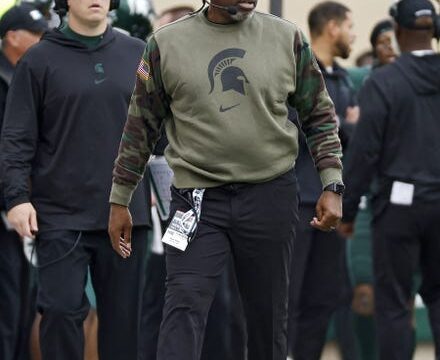
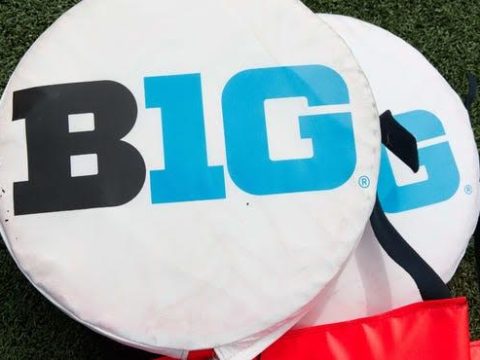
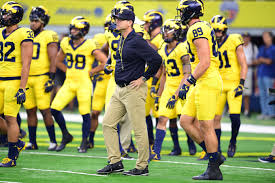
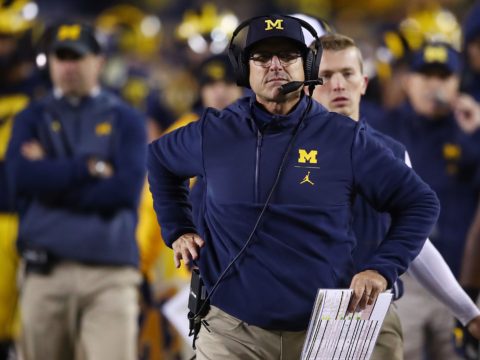


Hit the nail right on the head Dwayne Thomas. Leadership matters.
Roger Wise
B.S. Physiology 1976
Ph.D. Genetics 1983
Bravo, Dwayne Thomas. I was the Women’s Swim Coach from from 1973-1988, minus one year, because I waz required to get a Ph.D. to be considered for tenure, so attended another University, and coached at EMU, to pay for my tuition. We had many Athletic Directors in the fourteen years, I taught and coached, then just coached. I believe that all the various ADs over the years, were aware of the Land Grant mission of Michigan State University. I believe that Mr Beekman and Dr. Stanley are not aware of that, nor make that connection to this State of Michigan, the Great Lake State, with 11,000+ inland lakes in removing a large pool from the facilities available to the whole college community, in order to build new football facility, a cafeteria, I think. And because of that have used that as one of the reasons to cut the Swim Teams at Michigan State. Yes, I believe Dr. Hannah, Mr.Nunn, and my friend, Jack Breslin, would be disappointed.
Spartan Spirit throughout our lives is knowing that the difference between good and great is that little extra effort. – Biggie Munn
There was no extra effort given to keep Swimming and Diving. Within 5-10 years will the MSU Athletic Department consist of Football, Basketball, Hockey and enough women’s teams to satisfy Title IX?